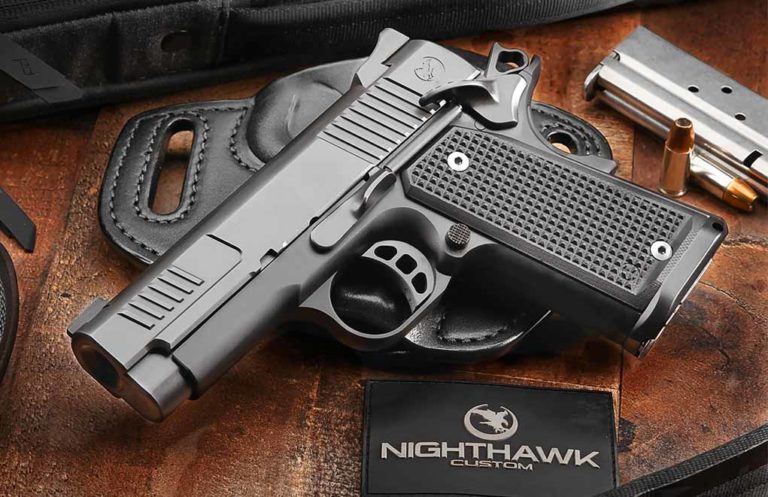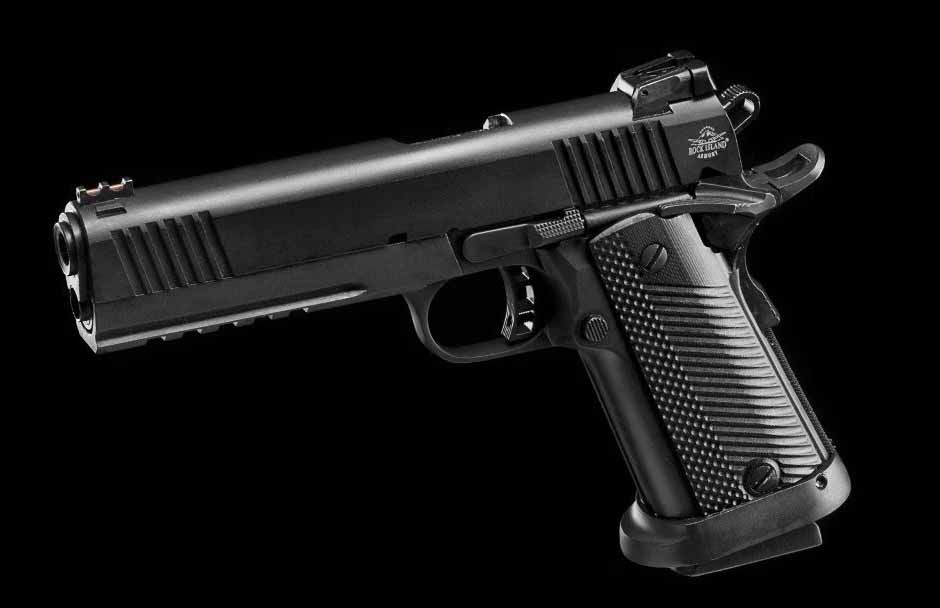

To some, the 9mm 1911 is an aberration, yet there are solid reasons to pick up the classic pistol in the smaller chambering.
How Does The 9mm 1911 Excel Over The .45:
- Better Capacity
- Among The Tamest Pistols
- Forgiving With Aluminum Frame
- More Affordable To Shoot
- Perfect Companion To A PCC
Intertwined from the beginning, there are few gun-cartridge combinations more storied or proven than the 1911 and .45 ACP. OK, maybe the Single-Action Army and .45 Colt, but that’s a different article.
As has been stated many times before, few handgun systems have more in-the-muck, bullets-are-flying proofing than the John M. Browning-designed pistol and cartridge. Why mess with a good thing? After all, honorable service in two World Wars should prove enough of a resume to satisfy even the most discerning firearm’s snob. In many cases it does.
Wed as ever, certain traditionalist segments of shooters won’t pick up a 1911 unless it’s chambered .45. In private, they might fondle one in .38 Super, but they’ll never tell anyone. And a 9mm 1911? The mere thought is an anathema to all that is right and good, best killed with fire and the earth beneath salted for good measure. If you count yourself among these ranks, it might be time to click on another article.
The fact is, the 9mm 1911 is a fine choice that offers some advantages over the traditional .45 ACP variety. Unclench those teeth; I didn’t state it made it a better gun overall. Simply, for some shooters the benefits of the medium-bore cartridge out of the classical design outweigh those of the big-bore brute.
Raise Your 1911 IQ:
- Best 1911 Pistol Options For Concealed Carry
- Power On The Cheap: Best Affordable 10mm 1911 Options
- Tips For Getting Your Perfect Custom 1911
- 4 Reasons Why The 1911 Pistol Remains On Top
- Thinking Soberly About 1911 Grips
Better Capacity
When talking single-stack configuration, the advantage isn’t as definitive. In this case, a 9mm 1911 beats out its .45 cousin by one or two rounds, generally boasting a 9+1 capacity. However, with double-stack 1911 options, the 9mm excels.
Yes, there are .45 options in the configuration, however, these guns top out around 14-rounds. On the other hand, the sky is nearly the limit with double-stack 9mm 1911s. Run the right magazines, a pistol such as the Rock Island TAC can have 22-rounds on tap. That’s no small advantage over things that go bump in the night or the clock in a practical pistol match stage.

Staccato (formerly STI) even extends the asset over to the sphere of concealed carry. The pioneers of the double-stack 2011 configuration, its 16-round C2 offers the exceptional characteristics of a 1911 with the capacity of a modern 9mm.
Among The Tamest Pistols
The .45 ACP doesn’t get the credit it deserves for its shootablity. It’s a pretty tame large bore. That said, it pales to the demure 9mm, particularly out of a 1911.
Given the pistol is constructed from metal—steel or an aluminum alloy—it has more heft than the majority of other pistols chambered for the “Nine”. It makes a difference; a 27-plus-ounce pistol eats up felt recoil, making the 9mm a veritable kitten.
In the realm of centerfire handguns, few options are friendlier to the recoil shy or make better trainers for new shooters than a 9mm 1911. This especially goes for Government-sized model. Additionally, if speed and accuracy are imperatives, you have them in spades with the marriage of the cartridge and gun.
Forgiving With Aluminum Frame
Dovetailing off the last point, the 9mm is superb out of an aluminum-framed 1911. Lighter and more conducive to concealed carry, these featherweights can prove too much for some in .45 ACP. This is rarely the case when chambered for the medium-bore Luger.
More Affordable To Shoot
Amid an ammunition drought (this was written in 2020), this point loses some of its salience. Nothing seems cheap or accessible right now.

In saner times, however, the 9mm generally proves much more economical to shoot in volume—especially when pitching range fodder. In most cases, it’s not unusual to find FMJ 9mm as much as 40-percent cheaper than .45 ACP, though 30-percent is probably a more common range. Ammo budget being proportionate to range time, if you want to shoot more, the 9mm 1911 is typically a safer bet.
Perfect Companion To A PCC
Say you’re like the rest of the shooting world and positively enamored with pistol-caliber carbines—a 9mm 1911 is more likely for you.
One of the attractions to the PCC is the ability to run the same ammo through both it and a handgun. That option is there for .45 ACP—take the wildly effective Heckler & Koch USC 45 for instance. Pickings get slim moving on from there, such as Hi-Point, TNW, JRC, Kriss and a few others.
On the flipside, 9mm calls the tune in pistol-caliber carbines, with more options than you can shake a stick at. Even more options abound if you count AR-style pistols into the mix. Expect more choices and price ranges matching a 9mm 1911 and PCC, thus a better chance of getting the exact handgun-carbine system you desire.
Load Up On More 9mm Knowledge:
- A Guide to the Top 9mm Pistols of All Time
- Best 9mm Carbine – A Guide to the Top Picks This Year
- Top Features to Look for in a 9mm Single Stack Pistol
- CCW Double Stack 9mm – High Capacity Meets Concealment
- Smallest 9mm Concealed Carry Pistols for Everyday Carry

Next Step: Get your FREE Printable Target Pack
Enhance your shooting precision with our 62 MOA Targets, perfect for rifles and handguns. Crafted in collaboration with Storm Tactical for accuracy and versatility.
Subscribe to the Gun Digest email newsletter and get your downloadable target pack sent straight to your inbox. Stay updated with the latest firearms info in the industry.

![Best Concealed Carry Guns In 2025 [Field Tested] Wilson Combat EDC X9S 1](https://gundigest.com/wp-content/uploads/Wilson-Combat-EDC-X9S-1-324x160.jpg)


![Best 9mm Carbine: Affordable PCCs [Tested] Ruger Carbine Shooting](https://gundigest.com/wp-content/uploads/Ruger-Carbine-Shooting-100x70.jpg)
![Best AR-15: Top Options Available Today [Field Tested] Harrington and Richardson PSA XM177E2 feature](https://gundigest.com/wp-content/uploads/Harrington-and-Richardson-PSA-XM177E2-feature-100x70.jpg)

Hey lets put jc whitney seat covers in our ferrari.